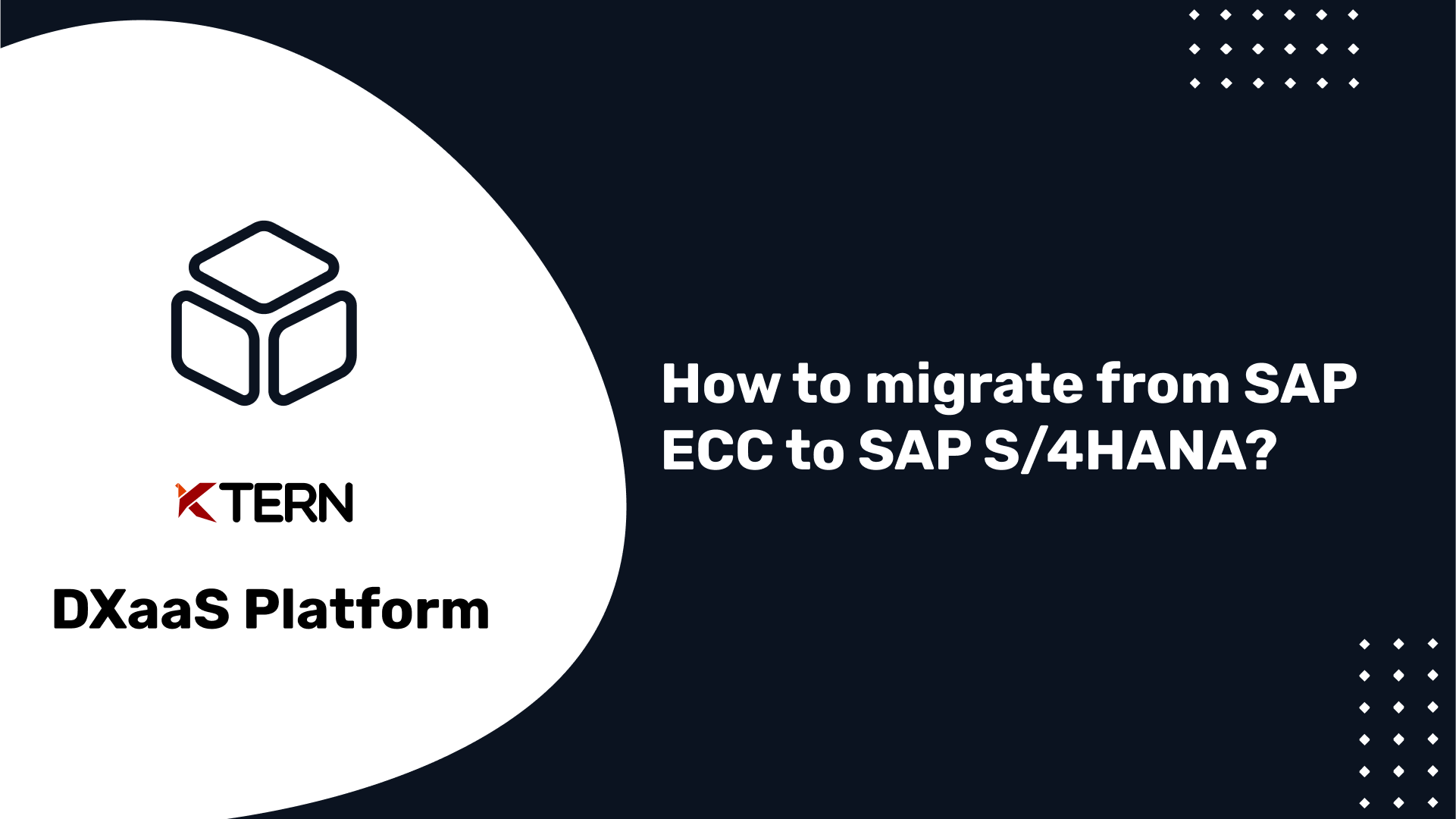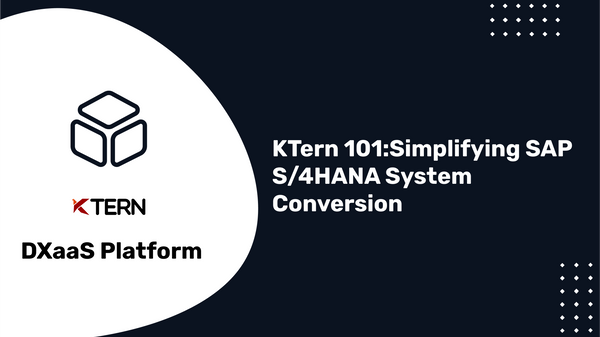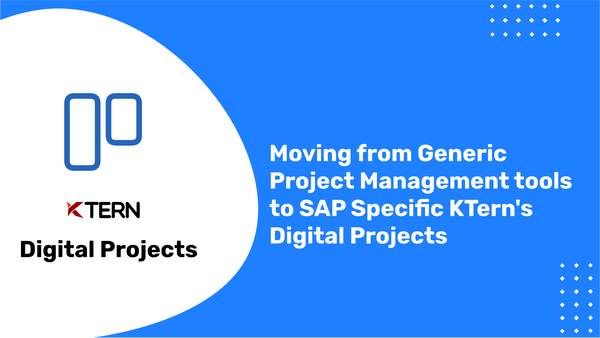How to migrate from SAP ECC to SAP S/4HANA?
Table of contents
- Introduction
- What is SAP ECC
- What is SAP S/4HANA
- How is SAP S/4HANA different from SAP ECC? (SAP ECC ERP vs SAP S/4HANA ERP)
- Options for SAP ECC to SAP S/4HANA Migration
- Brownfield or System Conversion Approach
- New implementation of SAP S/4HANA
- What is the first step for moving from SAP ECC to SAP S/4HANA?
- What are the key business benefits of moving to SAP S/4HANA?
- Conclusion

Introduction
Today, the digital economy makes it necessary for enterprises to persistently and periodically engage with their global customers. Digitized Enterprise environment results in organizational impact mainly in terms of a Business model or the way an organization does business.
This means that enterprise victory depends on two prime elements,
- The competence of an organization to flawlessly connect with its customers
- The competence of the organization to manage changes in its business models as quickly as they come along
This is where SAP S/4HANA comes into the picture. The Digital Core of SAP S/4HANA empowers the organization to carry out its business processes aligned with the new Digital economy by using a barrage of simplifications in User Interface, Data models, and Applications. Also, SAP S/4HANA empowers the enterprise to connect to the outside world at an accelerated pace, in this context machines and customers.
What is SAP ECC
SAP ECC (Enterprise Resource Planning Central Component) is the previous generation of SAP's enterprise resource planning software. It is a modular system that can be customized to fit an organization's needs and can work with third-party or customized applications. It offers a wide range of functionalities such as Finance, Logistics, HR, Product Planning, and customer service that enables the organization to optimize its business operations. However, it can also bring complexity as changes in one module can affect others. Support for SAP ECC will end in 2027 and organizations are encouraged to migrate to SAP S/4HANA.
What is SAP S/4HANA
SAP S/4HANA is short for SAP Business Suite 4 SAP HANA. It is the latest ERP (Enterprise Resource Planning) offering from SAP and is based on the SAP HANA in-memory database. It is designed to simplify and streamline business processes with features such as the Universal Journal, which serves as the single source of truth, and the new HANA database. It also includes a merger of CO and FI, a new general ledger, and mandatory Business Partners. Other features include Real-time MRP, Global Trade Services, and Extended Warehouse Management
Enterprises can migrate to SAP S/4HANA making use of the standard migration process. And, if these businesses have previously been running on SAP ERP 6.0, the correct method is system conversion. SAP S/4HANA is the next generation of business suite enterprise software from the house of SAP. SAP developers have painstakingly customized the solution to meet the challenges and requirements of the digital economy, especially with the help of the SAP HANA, the in-memory platform. Organizations can enhance the current processes along with realizing brand new processes to benefit from the edge against their opponents in the digital economy.
SAP S/4HANA serves as the digital code of enterprise, which enables the enterprises to emphasize on digital processes. This is where enterprise situations are implemented efficiently and promoted with equal competence. SAP S/4HANA does not just serve as the next version of the SAP Business Suite but it also stands for a brand-new product line. Thus, the migration to SAP S/4HANA is not a unique task like database migration or upgrade. Conversely, it includes the complete system landscape, and therefore companies should plan such a transformation by measuring their optimal future SAP architecture. This will make the user’s life much easier. Considering the transformation is comprehensive in nature, it enables heterogeneous and complex IT system landscapes to be taken out of the picture. This will lay the foundation for processes which are more streamlined and simpler.
While evaluating the best path from SAP ECC to SAP S/4HANA, the target architecture under consideration is crucial. As discussed before, enterprises that are already using SAP ERP 6.0 with an improved package or higher, can directly migrate to SAP S/4HANA using a system conversion.
How is SAP S/4HANA different from SAP ECC? (SAP ECC ERP vs SAP S/4HANA ERP)
SAP S/4HANA and SAP ECC are both ERP (Enterprise Resource Planning) software offered by SAP, but there are significant differences between the two.
- Database: SAP S/4HANA is based on the SAP HANA in-memory database, which allows for real-time analysis and processing of large amounts of data. SAP ECC, on the other hand, can be run on a variety of databases, including HANA, but it is not optimized for the in-memory technology.
- User Interface: SAP S/4HANA has a simplified and modern user interface that is designed to be more user-friendly and efficient.
- The Universal Journal: SAP S/4HANA has a Universal Journal, which serves as the single source of truth for financial data, making it easier to access and analyze financial information.
- MATDOC: SAP S/4HANA has a new line item for inventory management called MATDOC, which allows for real-time inventory management.
- CO & FI Merger: SAP S/4HANA has a merger of the CO (Controlling) and FI (Finance) modules, which simplifies financial management and reporting.
- Change in Custom Code: SAP S/4HANA is designed to minimize the need for custom code, which can simplify system maintenance and upgrades.
- Business Partners: Business Partners are mandatory in SAP S/4HANA and are used for managing customer and vendor relationships.
- Real-time MRP: SAP S/4HANA has real-time MRP (Material Requirement Planning) which allows for immediate calculation of material requirements and inventory management.
- Global Trade Services: SAP S/4HANA includes Global Trade Services, which allows for efficient management of global trade processes.
- Extended Warehouse Management: SAP S/4HANA has an introduction of Extended Warehouse Management which allows for real-time inventory management and tracking of warehouse operations.
It is important to note that SAP ECC has reached the end of its life and SAP is phasing out ECC and promoting the move for SAP ECC users to SAP S/4HANA.
Options for SAP ECC to SAP S/4HANA Migration
Going by the reasons and context stated above, the SAP S/4HANA adoption for enterprise processes is desirable, to say the least. In the future, it may very well be inevitable. Businesses new to SAP can go straight ahead with the implementation of SAP S/4HANA. But the enterprises already powered by previous versions or products of SAP will need to get some queries out of the way first.
It is essential that a prospective customer should analyze all options regarding key parameters and decision factors when it comes to adopting SAP S/4HANA effectively.
Brownfield or System Conversion Approach
Enterprises already operating on SAP (ECC) will find that adopting SAP S/4HANA is simple by using the system conversion method. A pre-existing SAP ECC instance can be transformed into an SAP S/4HANA instance with all the historical data when supported by efficiently documented processes going hand in hand with system conversion tools. This migration scenario is standard and established, and has detailed protocols for execution, including numerous technical steps to reach SAP S/4HANA and steps for code optimization for the Custom code created in the pre-existing system.
System conversions to SAP S/4HANA will hold the actual system ID for customization, interface, authorizations, data, and development. This is otherwise called an in-place migration. Systems which are powered by SAP ERP 6.0 using enhancement package 0 or higher can undergo migration to SAP S/4HANA directly, if the system is previously a Unicode system. After the release of SAP NetWeaver 7.5, SAP is set to support only Unicode systems. If an enterprise system is not Unicode, it must be converted into Unicode prior to the conversion. The system conversion to SAP S/4HANA is aided by SUM-DMO, the software update manager with the data migration option. This will support enterprises in upgrading and migrating database in a single step, eliminating massive amounts of downtime.

KTern.AI is an All-in-One Digital Workplace for SAP Projects with 12 inbuilt modules designed to automate and manage SAP S/4HANA Migrations from start to finish.
Before Conversion
To evaluate the readiness for migration, enterprises are required to adjust their IT systems to match the Framework needs of SAP S/4HANA. A reliable method to carry out such analysis should be executed as soon as possible to get a bird’s eye view of SAP S/4HANA Conversion, the business, technical, and functional impact of conversion, and the adjustments to be made. Furthermore, the measures which are preparatory in nature must be assessed before planning the migration from SAP ECC to SAP S/4HANA.
KTern provides a comprehensive SAP S/4HANA Readiness Assessment within a week to understand the business, functional, and technical impact of converting the existing SAP ECC system to SAP S/4HANA. The SAP S/4HANA Fitness Report generated at the end of the assessment helps define the adjustments to be made for SAP S/4HANA Migration through the system conversion path and draft the L1 plan for conversion with the right effort, timeline, and total cost of conversion.
During Conversion
Driven by SAP Activate and the 893+ tasks defined by it, KTern is the perfect toolkit during SAP S/4HANA Conversion. A comprehensive project management kernel, a futuristic custom code management module, and an RPA powered Test Suite are just some of the features inbuilt in KTern for SAP S/4HANA Conversion.
After Conversion
Unlike most tools in the market, KTern is a highly intelligent product which continues to provide value even after the migration from SAP ECC to SAP S/4HANA. Landscape & System Management, Business Process Optimization, and License Auditing & Optimization are just some of the modules which support organizations live on SAP S/4HANA.

Schedule a guided demo for an express session on the role and value of KTern for SAP S/4HANA Conversion and a demo of the All-in-One SAP S/4HANA Conversion Accelerator.
New implementation of SAP S/4HANA
SAP S/4HANA Conversion is an idealistic path. But it is not applicable for some enterprises. Some enterprises do not have optimal SAP deployment, and this leads to the collection of massive amounts of data. In this scenario, it is best to drop efforts which are too cumbersome and resort to a brand-new SAP S/4HANA implementation.
Migration to SAP S/4HANA can be performed through an intermediate step to SAP S/4HANA Finance. Furthermore, this is an add-on that is made available for enhancement package 7 for the 1503 version or even as an add-on for enhancement package 8 for the 1605 version. To reiterate, such migration is made possible in a single step and for this, the system must be Unicode. In addition, SAP offers ABAP reports to check the need for this type of migration. This report must be executed in the local SAP ERP system.
What is the first step for moving from SAP ECC to SAP S/4HANA?
The first step for moving from SAP ECC to SAP S/4HANA is to conduct a thorough assessment of your current SAP ECC landscape and business processes. This assessment should include a review of your current system architecture, customizations, and integration points. The goal of this assessment is to understand the scope of the migration and identify any potential challenges or roadblocks.
Additionally, it's important to analyze the business case for the migration and to identify the key benefits that SAP S/4HANA can bring to the organization. This will help in creating a comprehensive migration plan and identifying the resources that will be needed to execute it.

Once the assessment is complete, the next step would be to develop a detailed migration plan. This plan should include the timeline for the migration, the resources needed, and a detailed breakdown of the tasks that need to be completed. It's important to involve all the relevant stakeholders in the development of the migration plan, including IT, business leaders, and any external partners or vendors that will be involved in the migration.
Finally, it's important to test the migration plan thoroughly before going live, and to have a well-defined rollback plan in place. Having a robust testing process in place will help ensure that the migration is successful, and that the organization can continue to operate without interruption.
What are the key business benefits of moving to SAP S/4HANA?
There are several key business benefits of moving to SAP S/4HANA from SAP ECC. These include:
- Improved Performance: The in-memory technology used in SAP S/4HANA allows for faster data processing and real-time analysis, which can lead to improved performance and faster decision-making capabilities.
- Streamlined Processes: The simplifications in the user interface and data models in SAP S/4HANA can make it easier for users to navigate and access the information they need, leading to more efficient and streamlined processes.
- Better Data Management: The Universal Journal in SAP S/4HANA serves as the single source of truth for financial data, making it easier to access and analyze financial information.
- Real-time Inventory Management: The MATDOC feature in SAP S/4HANA allows for real-time inventory management, which can help organizations make more accurate and timely inventory decisions.
- Improved Financial Management: The merger of CO and FI in SAP S/4HANA simplifies financial management and reporting, making it easier to access and analyze financial information.
- Minimized Custom Code: SAP S/4HANA is designed to minimize the need for custom code.
Conclusion
Enterprises have multiple options to adopt SAP S/4HANA. Businesses that are not on SAP ECC will require a fresh implementation of SAP S/4HANA System. Businesses which are running SAP ECC currently will need a thorough assessment of the existing setup and the utilization of SAP, which is a prerequisite to decide which path of adoption to take on. System conversion is the best method for the most optimal setup. However, there may be scenarios in which a system conversion is not optimal. In such situations, it is best to go ahead with brand new implementation of SAP S/4HANA while taking on standard best practices.
How KTern can help?
KTern and it’s partner ecosystem can help you during each phase of your SAP S/4HANA Conversion Project from start to finish.
In the discovery stages, KTern can help assess the 14 mandatory parameters to be analyzed before you even consider the system conversion project and define if you ready to make the move to SAP S/4HANA based on your business requirements and current landscape. This will be useful to build the business use case for SAP S/4HANA tailor made for your IT strategy. Once you have the business case for the SAP S/4HANA project, you can then define the project effort and timeline to ensure that the SAP S/4HANA migration project is completed with the most optimum total cost of conversion.
During the project stages, KTern provides a comprehensive project management kernel to automate and manage the 893 tasks defined by SAP Activate, the only SAP Approved methodology for SAP S/4HANA Conversion. KTern also provides 2 solutions built based on RPA to help with your SAP S/4HANA Conversion Project:
- Custom Code Management to auto-remediate the incompatible custom code based on pre-defined scenarios. In addition, custom code management also allows you to manually correct your custom code through KTern’s inbuilt custom code corrector platform.
- Intelligent test suite to leverage rigorous testing, manage issues and defects, and resolve them with automated recommendations with the help of intelligent test scripts and test scenarios.
In addition to all these features, KTern provides a unique feature that is not yet available anywhere else as on this date of May 20, 2019. It resolves one of the most effort-intensive tasks during data migration from SAP ECC to SAP S/4HANA – Data Validation. KTern automates data validation for master data and transaction data. What would normally take weeks of man effort and excel sheets has now been reduced to mere days with KTern’s futuristic data validation suite.
So, what are you waiting for? Get in touch with us and we’ll get started with automating your path to SAP S/4HANA.




